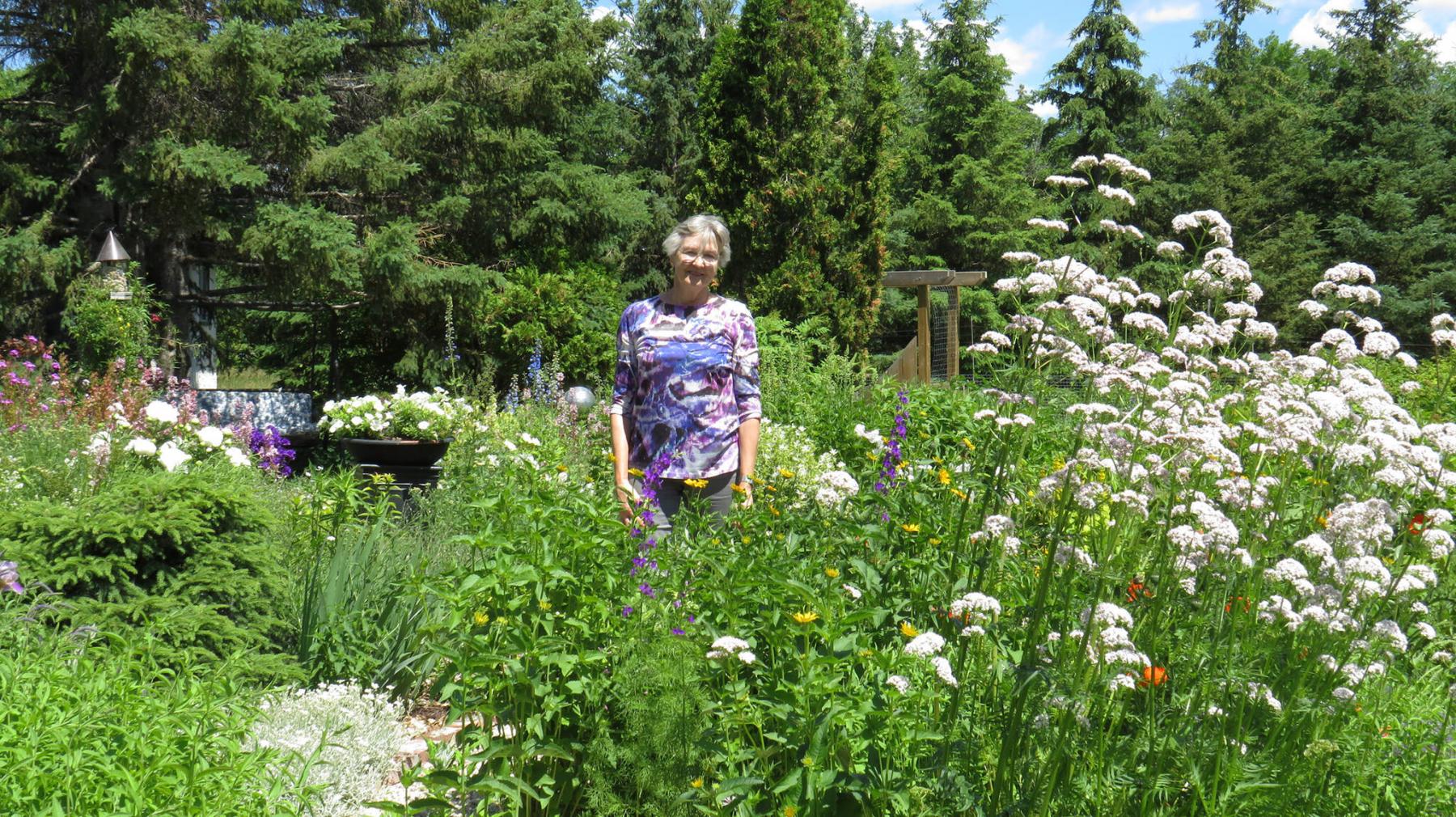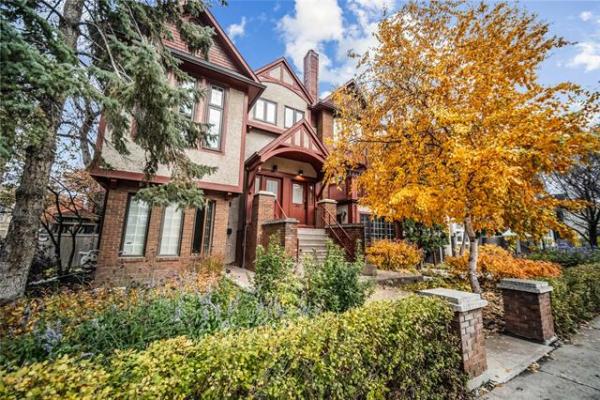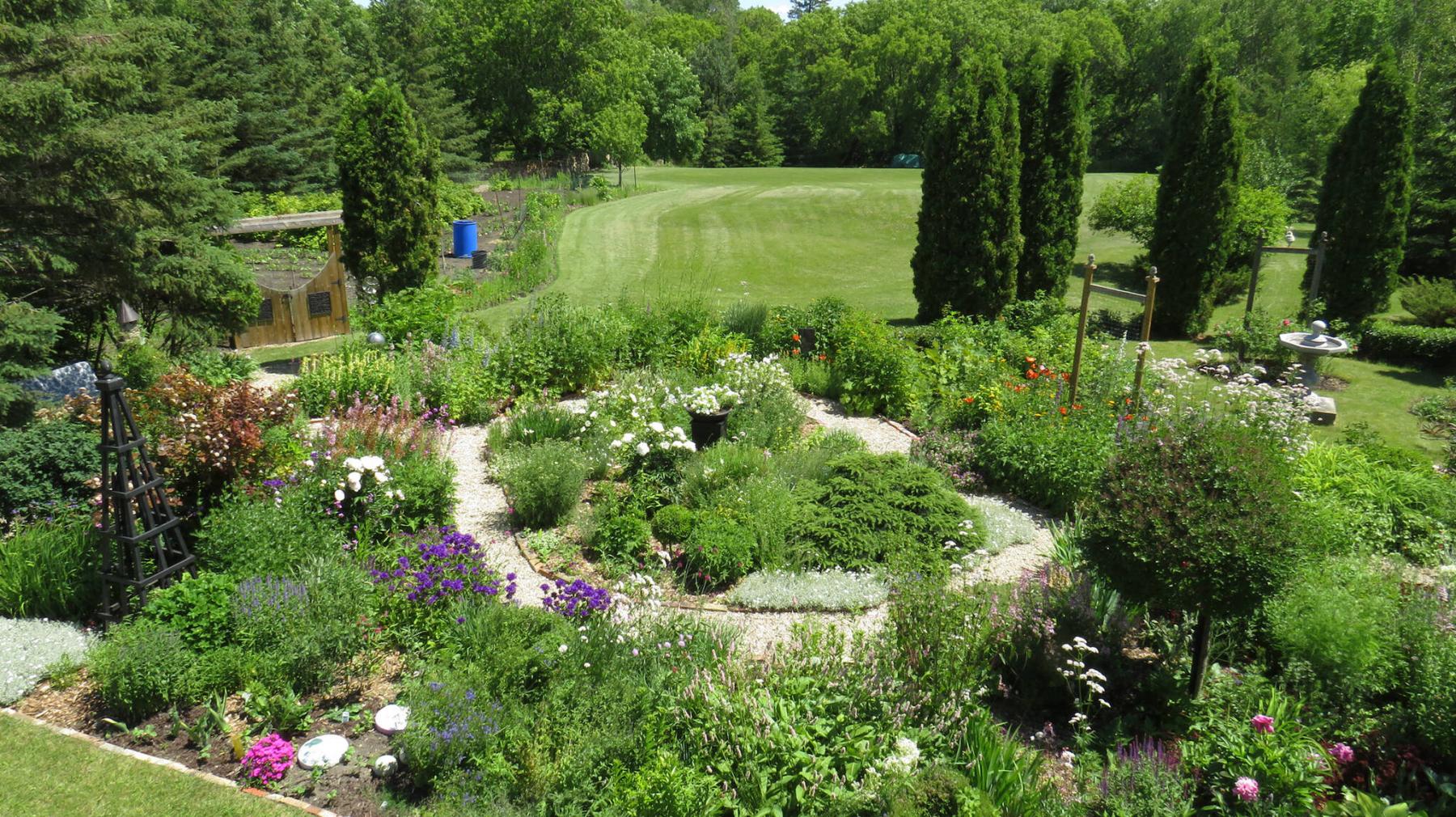
Leila and Karl Wegert’s country garden features pea gravel pathways, a white garden, and countless flowering perennials.
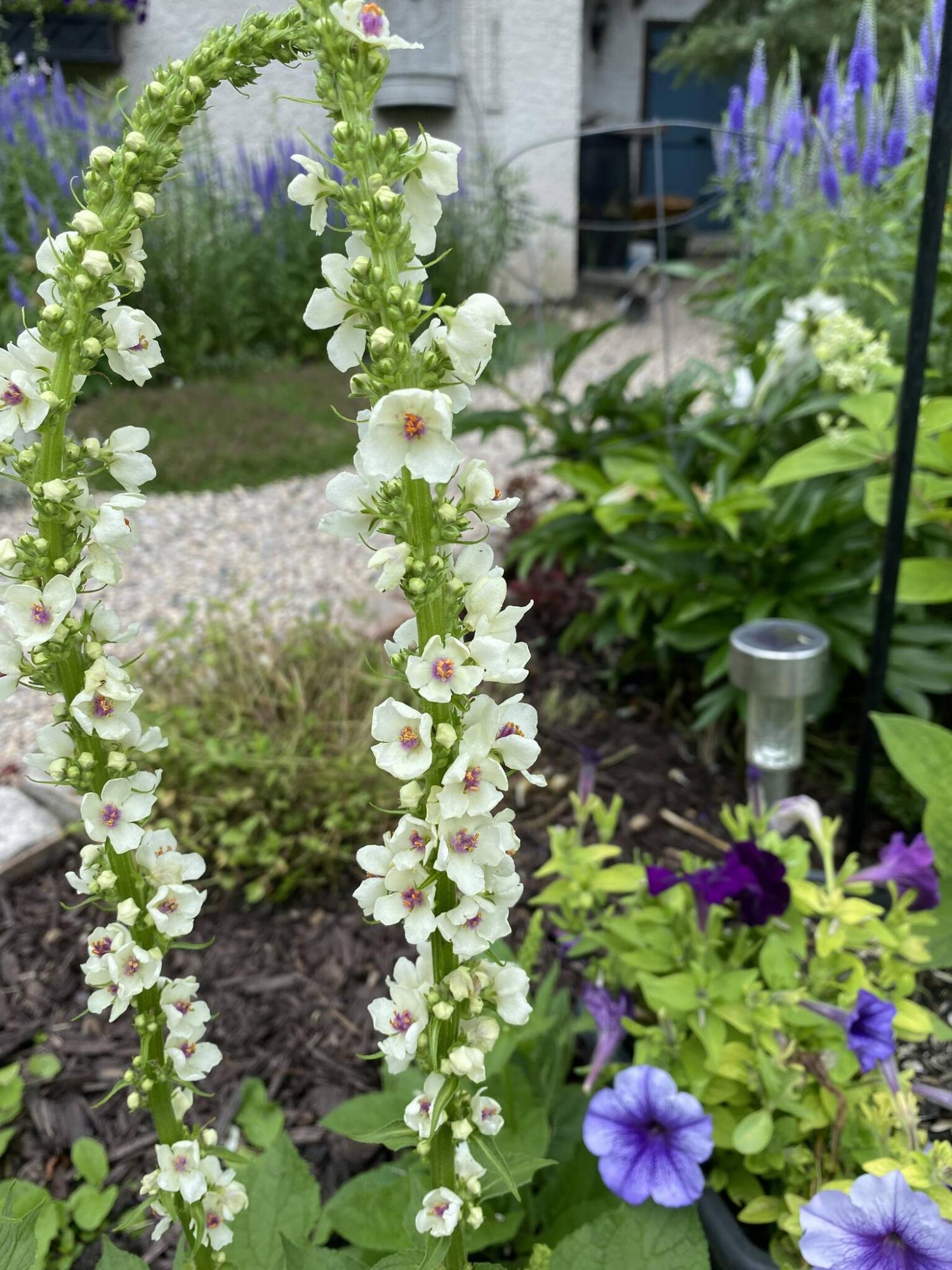
Leila Wegert A delicate beauty, nettle-leaved Verbascum is a study in detail with white flowers that have purple centres and orange eyes.
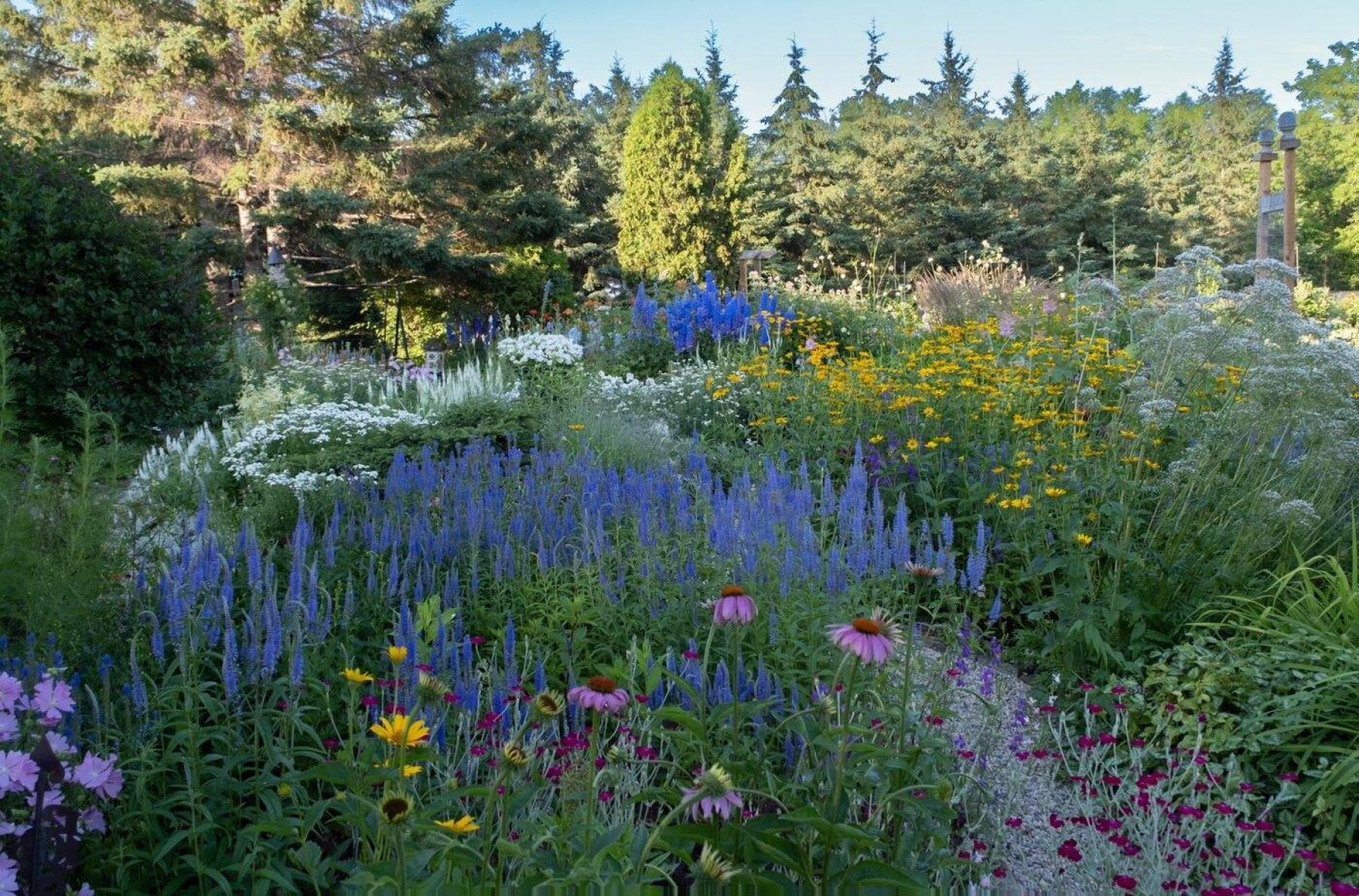
Anugrah Patel Massing plants creates sweeps of bold colour for impact. Lower right: Rose campion.
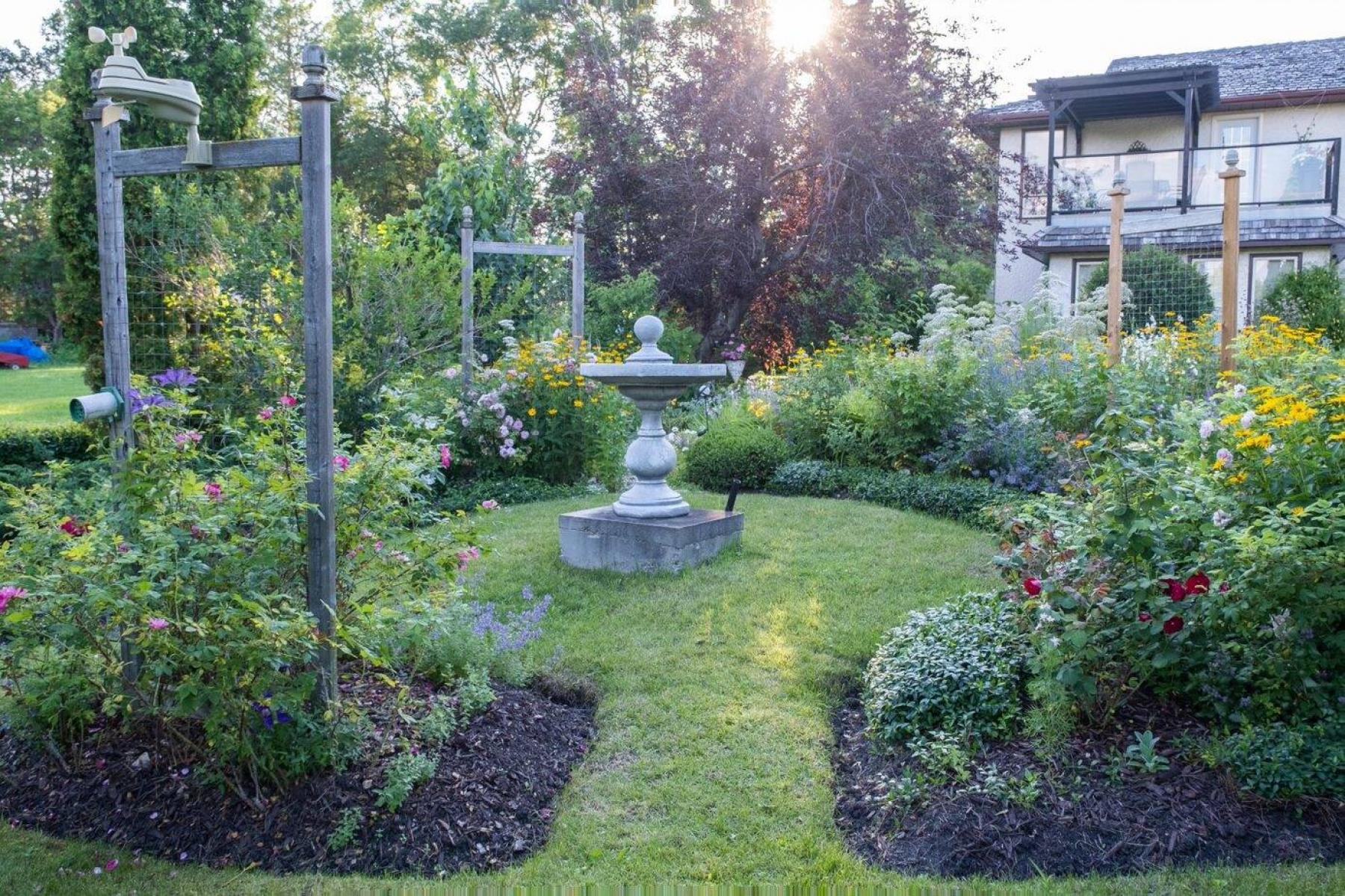
Anugrah Patel Weathered cedar trellises accent curved flower beds planted with roses and perennials.
Visitors who toured Leila Wegert’s country garden in the RM of St. Andrews at last week’s Red River North Tourism Garden and Art Tour had the opportunity to get a first-hand look at unique and fabulous varieties of perennials that flower abundantly and grow in impressive clumps.
Wegert’s well-organized, formal-type garden has an elegant and graceful flow. Stunning visual impact has been achieved through the use of massing where one type of plant is grouped together. On my visit to Wegert’s garden in early July, I was struck by the bountiful size of her many shrub-sized specimens of the Gas Plant (Dictamnus albus) which grow in an area designated as the white flower garden. Wegert grows both the white-flowered variety as well as Dictamnus albus var. purpureus which has pink-purple flowers. Planted in groups and in glorious bloom, the early summer display consisted of literally hundreds and hundreds of fragrant flowers on upright stems. Once the flowers finish blooming, they transition in mid-summer to star-shaped seedpods for season-long ornamental interest and texture.
Intriguing plant texture is one of the hallmarks of Wegert’s garden design and so, too, is the use of varying heights. Valerian officinalis, also known as garden heliotrope, is a tall plant that can grow to a height of six feet (1.8 m). The flower inflorescence is an open branched cluster of tiny, trumpet shaped, vanilla-scented flowers that are a soft pinkish-white. The flower branching is somewhat like that of Verbena bonariensis however the tiny flowers have a much finer texture. Valerian root has been used since ancient Greek and Roman times as a medicinal herb to promote sleep.
Next to Valerian, Wegert grows another intriguing plant called Phlomis (Jerusalem Sage, Sage-leaf Mullein), an unusual and architectural perennial with narrow, grey-green leaves and whorls of hooded flower clusters. Wegert, who is a member of Selkirk District Horticultural Society, planted Phlomis in her garden about four years ago from a seedling given to her by June Minish, a fellow garden club member. “It is an interesting plant because of the way the flowers grow,” says Wegert, “and it blooms for a long time.”
More of us are familiar with Giant Fleece Flower (Persicaria polymorpha) which is enjoying a resurgence of interest. Wegert has planted a fine specimen next to the gate at the entrance to her garden. Each year, this herbaceous perennial with its large creamy white flower plumes, attains a height of nine feet (274 cm). Wegert has started several new fleece flower plants simply by planting stems directly into soil-filled pots and keeping them moist. She shares them with others and donates several to the annual plant sale hosted by SDHS.
But Wegert also grows a much lesser-known fleece flower variety — Persicaria bistorta Superba (Bistort). This plant caught my eye immediately. It has a moderate height, about 27 inches tall (65 cm). The dark green foliage consists of very large, lance-shaped leaves. Masses of upright spikes of softly-coloured, fluffy pink bottlebrush flowers float above the dense mound of leaves. Definitely this is a plant that should be more widely available. Sun-loving, Bistort is hardy to Zone 3 as well as deer resistant and attractive to pollinators.
Verbascum (mullein) is an old-fashioned perennial that has also been used for its medicinal properties, mainly for respiratory diseases, throughout history. A statuesque plant, there are several different types that grow in Wegert’s garden, including Verbascum Chaixii album, also known as the nettle-leaved Verbascum, which has beautiful white flowers with purple centres and orange eyes. It features hairy stems, woolly leaves, and grows to a compact height of about 3 feet (90 cm) Another variety is Verbascum phoeniceum which has pure white flowers with purple eyes. Many varieties of Verbascum will self-seed.
On my visit, giant scabious (Cephalaria gigantea) had not yet reached its mature height but the flower stalks have since grown to at least six feet (1.8 m). At first glance, the rounded flower with its domed central disc suggested to me that this was the dainty Scabiosa pincushion plant. Although related, giant scabious with its buttery yellow flowers makes a much bigger impression in the garden.
Wegert’s property is approximately 2.5 acres. She and her husband, Karl, moved from Quebec to Manitoba in 2004. Leila was born near Steinbach and Karl, a retired history professor, was born in Germany and grew up in Winnipeg. They have a cottage at Hillside Beach which is on the east side of Lake Winnipeg. It was when Wegert was driving home one day in 2004 from her cottage that she spotted a sign advertising the SDHS plant sale. She popped into the sale and purchased 13 plants for $17.00. “I was so impressed because we had all this space to fill,” says Wegert. A long-time member of SDHS, Wegert donates around 300 plants annually to the SDHS plant sale. She has already identified several varieties of her garden plants that she plans to either divide, collect seeds from, or propagate from cuttings.
There are key takeaways from every garden visit. One of mine is to mark my 2023 calendar for the SDHS plant sale which is always held on the last Friday in May.
Wegert grows several plants with deep purple or rich blue flowers. In early summer, Clustered Bellflower shows off its beautiful clusters of purple flowers followed by gorgeous sweeps of Veronica (Spiked Speedwell) with spikes of dark violet-blue flowers. During last week’s RRNT garden tour, several visitors inquired about the brilliant, blue-flowered larkspur that grows throughout her garden. A prolific self-seeder, larkspur is related to delphinium but is a true annual. The larkspur that grows in Wegert’s garden is originally from her mother’s garden in Steinbach. Another plant that sparked a great deal of interest is Rose campion (Lychnis coronaria) which has bright magenta flowers and velvety, silvery-grey foliage and stems.
Wegert also grows several beautiful rose shrubs including Lambert Closse, a classic hybrid tea rose with double pink flowers that is part of the Canadian Explorer Series. Her rose garden is in a separate area of her property and is framed by weathered cedar trellises built by her husband. A backdrop of handsome Brandon cedars adds an air of formality. Initially, Wegert planted a hedge of Cotoneaster shrubs between the Brandon cedars, however, some of the shrubs succumbed to fire blight, a bacterial disease. While some of the Cotoneaster shrubs have been restored by pruning out the affected portions, Wegert has established a delightful and innovative low herbaceous hedge using Vinca Minor periwinkle. She trims the hedge by hand with upholstery shears once it has finished blooming. The leaves are dark green and glossy. A length of Vinca Minor borders the edge of one of her beds of roses.
In August, Wegert’s garden will have even more blooms from monkshood, Russian Sage, plume poppies, daylilies, and hydrangeas.
colleenizacharias@gmail.com
Colleen Zacharias is writing a monthly newsletter for the Free Press that is loaded with advice, ideas and tips to keep your outdoor and indoor plants growing. Sign up to have Winnipeg Gardener delivered conveniently to your own inbox at wfp.to/wpggardener.

